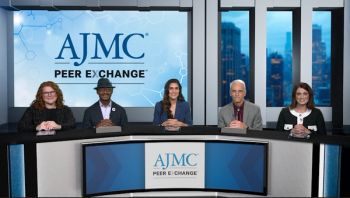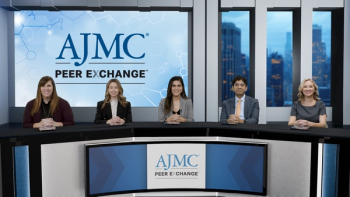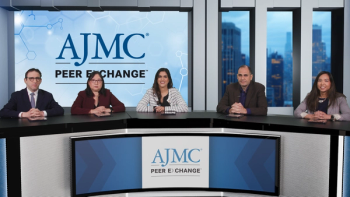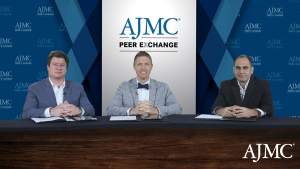
Experts discuss the critical challenges in accessing innovative treatments for relapsed refractory multiple myeloma, emphasizing equity and education.

Experts discuss the critical challenges in accessing innovative treatments for relapsed refractory multiple myeloma, emphasizing equity and education.



Experts discuss the evolving role of bispecific antibodies in multiple myeloma, highlighting treatment advancements and strategies for optimal patient care.

Panelists discuss how AML treatment has entered an exciting era of personalized medicine with increasing oral options and targeted therapies, while identifying immunotherapy as a major unmet need and expressing optimism about patients achieving long-term survival on current regimens.

Panelists discuss how future AML treatment will likely involve sophisticated decisions about triplet combinations, optimal sequencing of targeted agents, and balancing efficacy with toxicity through either upfront intensive approaches or thoughtful sequential doublet therapies.

Panelists discuss how payer access challenges can determine whether patients receive therapy at all, with strategies including hospitalization for first cycles, advance prescription preparation, and recognition that oral regimens significantly impact quality of life for patients requiring lifelong treatment.

Panelists discuss how evolving policy reforms will reshape oncology research by balancing innovation, access, and affordability.

Panelists discuss how IRA-driven BTK inhibitor price changes could shift payer preferences, necessitating vigilance to preserve clinical integrity in treatment selection.

Panelists discuss how the IRA’s drug pricing reforms aim to improve affordability but may influence future oncology innovation.

Panelists discuss how integrating safety and access considerations into oncology policy can create more equitable, patient-centered coverage models.

Panelists discuss how utilization management limits clinical autonomy and advocate for reforms that preserve shared, patient-centered decision-making.

Panelists discuss how payers should interpret black box warnings with clinical context to prevent unnecessary restrictions on safe, evidence-based treatments.

Panelists discuss how integrating real-world evidence into coverage frameworks can enhance decision-making and align payer policies with actual patient outcomes.

Panelists discuss how outdated coverage decisions can worsen outcomes and increase costs by delaying access to safer, evidence-supported BTK inhibitor therapies.

Panelists discuss how payer coverage restrictions often conflict with NCCN guidelines for BTK inhibitor therapies in CLL, impeding evidence-based care.

Panelists discuss how outdated coverage models lag behind oncology innovation, calling for dynamic policies that reflect evolving clinical evidence.

Panelists discuss how step edits hinder timely cancer treatment and urge policies that prioritize evidence-based access over cost-driven sequencing.

Panelists discuss how utilization management policies can delay oncology care and call for reforms that better align oversight with clinical evidence.

Panelists discuss how PBMs shape oncology access and stress the need for transparency to align financial control with clinical priorities.

Panelists discuss how managing oral therapy toxicities requires preemptive planning, multidisciplinary team involvement, patient and family education, and close monitoring for drug interactions and adherence issues, emphasizing the need for experienced centers with proper support infrastructure.

Panelists discuss how implementing oral regimens faces significant operational barriers including formulary restrictions, prior authorization requirements, insurance coverage differences between inpatient and outpatient settings, and the need for careful monitoring protocols, especially during initial treatment cycles.

Panelists discuss how aligning evolving payer policies with real-world oncology practice is key to sustaining timely and equitable patient access.

Panelists discuss how national policy reforms are reshaping oncology care by balancing affordability efforts with the need to preserve access and innovation.

Panelists discuss how oral azacitidine plus venetoclax represents a transformative advance toward completely oral regimens that could dramatically improve quality of life and accessibility, though challenges remain regarding cost, insurance coverage, and the complexity of managing multiple oral agents.

Panelists discuss how emerging therapies like menin inhibitors show promise based on strong preclinical data and clinical responses, while CD47 inhibitors have faced setbacks in phase 3 trials, with the greatest potential for novel agents likely in frontline combination settings.

Panelists discuss how venetoclax management requires standardized approaches to duration, bone marrow biopsy timing, growth factor use, and azole antifungal selection, with practices varying significantly between centers and the need for consistent protocols to optimize patient outcomes.

Panelists discuss how IDH inhibitors, particularly ivosidenib combined with azacitidine, represent potentially the greatest advance in AML treatment due to significant overall survival improvements, though adoption challenges include waiting for mutation results and limited patient applicability.

Panelists discuss how the treatment landscape has evolved from limited options to include hypomethylating agents and venetoclax combinations, with emerging oral formulations promising greater accessibility while requiring careful consideration of patient selection and toxicity management.

Panelists discuss how combination trials like VIALE-A and VIALE-C have demonstrated venetoclax’s survival benefits when added to hypomethylating agents, opening doors for numerous combination studies while emphasizing the need for randomized trials to prove clinical benefit in different disease contexts.

Published: September 3rd 2024 | Updated:

Published: September 3rd 2024 | Updated:

259 Prospect Plains Rd, Bldg H
Cranbury, NJ 08512
© 2025 MJH Life Sciences®
All rights reserved.
